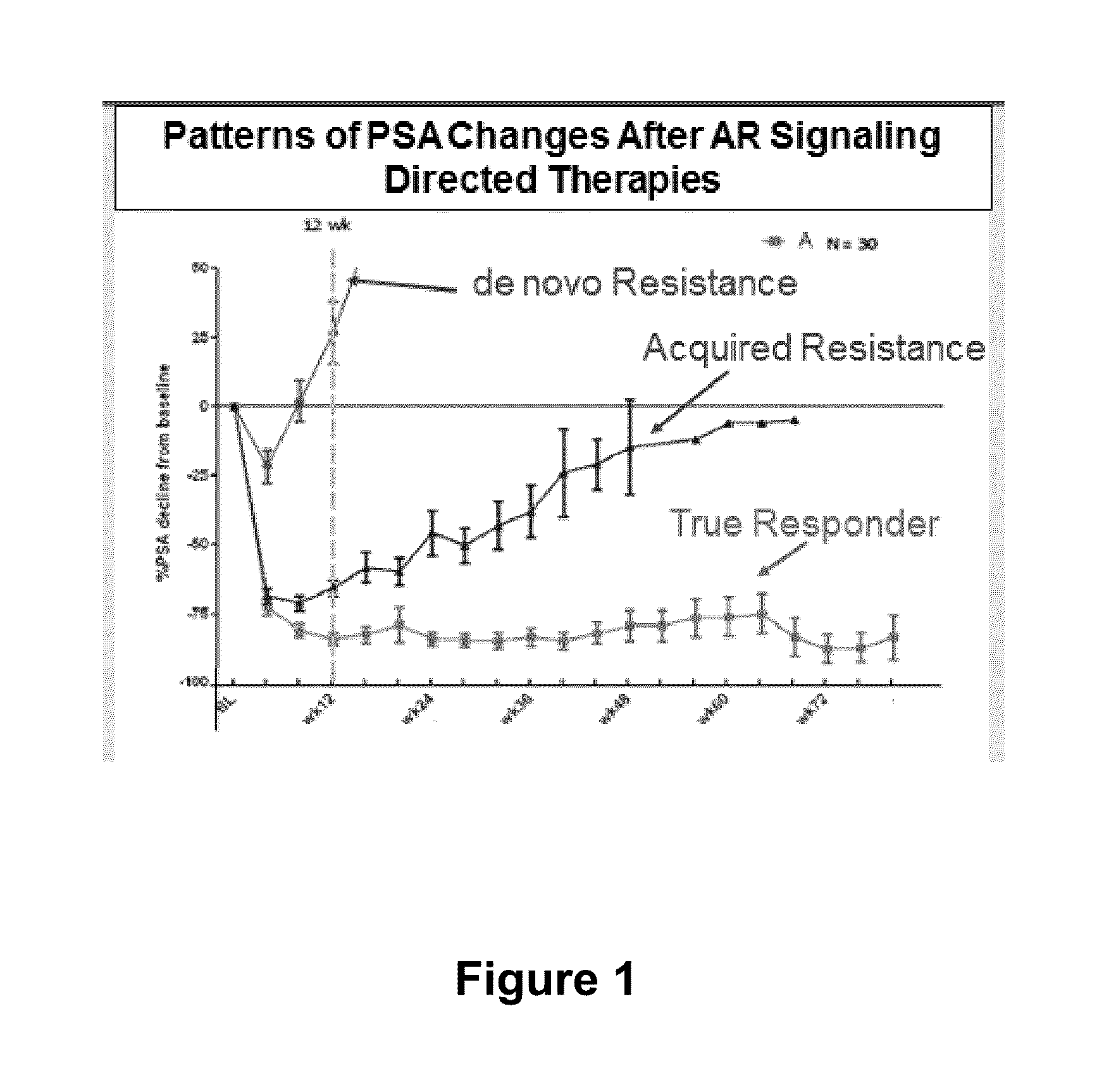Circulating tumor cell diagnostics for biomarkers predictive of resistance to androgen receptor (AR) targeted therapies
a technology of androgen receptor and targeted therapies, applied in the field of circulating tumor cell diagnostics for biomarkers predictive of resistance to androgen receptor (ar) targeted therapies, can solve the problems of patients losing the therapeutic window, and unable to achieve optimal sequencing or combination of these agents
- Summary
- Abstract
- Description
- Claims
- Application Information
AI Technical Summary
Benefits of technology
Problems solved by technology
Method used
Image
Examples
example 1
Characterization of CTCs and CTC Subpopulations in Progressive mCRPC
[0103]48 samples from 21 unique progressive mCRPC patients treated with androgen receptor targeted (AR tx) therapies, 9 (43%) on Abiraterone plus Prednisone (AA+P) and 12 (57%) on Enzalutamide (E). Samples were collected and shipped to Epic Sciences, where cells were stained and CTC identified by fluorescent scanners and algorithmic analysis. CTCs, defined as classic (CK+CD45− w / intact DAPI nuclei and distinct), apopotic (CK+, CD45−, non-intact nuclei) and CK− (CK−, CD45−, intact and distinct) were identified. CTCs reported per mL of blood and were examined for AR, PTEN & ERG. CTC data were analyzed in context of PSA, Veridex CTC (reported per 7.5 mL of blood), and clinical history.
[0104]With Epic, all 21 pts had detectable CTCs (mdn 23 cells / ml, range 2 to 249), whereas with Veridex, 14 (67%) pts had >5 CTC / 7.5 ml (mdn 5 cells / 7.5 ml, range 0 to >200).
TABLE 2Baseline AR Expression (Epic CTC)Baseline AR Expression (...
example 2
Characterization of CTCs and CTC Subpopulations in Progressive mCRPC
[0107]32 samples from 30 unique progressive mCRPC Pts treated with androgen receptor targeted (AR tx) therapies; 14 / 30 (46.7%) on Abiraterone plus Prednisone (AA+P) and 16 / 30 (53.3%) on Enzalutamide (E). Samples were collected and shipped to Epic Sciences where cells were stained and CTC identified by fluorescent scanners and algorithmic analysis (FIG. 3). CTCs, defined as traditional (CK+CD45− with intact DAPI nuclei and morphologically distinct), apopotic (CK+CD45−, non-intact nuclei) and CK− (CK−CD45−, intact and morphologically distinct) were identified (FIG. 4). CTCs reported per mL of blood were examined for AR expression by immunofluorescence (IF), and for PTEN loss and ERG rearrangements by FISH. CTC data were analyzed in context of PSA, CellSearch® CTC count (reported per 7.5 mL of blood), and clinical history.
[0108]Using Epic Sciences CTC platform, 26 / 30 (86.7%) pts had >5 traditional CTCs / 7.5 mL of blood ...
example 3
Predictive Biomarkers of Sensitivity to Androgen Receptor Signaling (ARS) and Taxane Based Chemotherapy in Circulating Tumor Cells (CTCs) of Patients (Pts) with Metastatic Castration Resistant Prostate Cancer (mCRPC)
[0110]91 patient blood samples collected from 79 patients for CTC analysis with the Epic Sciences platform prior to treatment (27 pre-A, 28 pre-E, 28 pre-D, 8 pre-C). Epic analysis identified traditional CTCs (CK+, CD45−, intact nuclei, morph distinct), CK− CTCs (CK−, CD45, intact nuclei, morphology distinct), small CTCs (CK+, CD45−, intact nuclei, small cell size), and CTC clusters. If staining for AR N, AR C exp was performed, digital pathology algorithms analyzed CTC morphology. A classifier was developed to associate clinical phenotypes with outcome to a specific agent.
[0111]A & E biomarker signatures included: AR N / C exp. & presence of CK+, AR+, Nucleoli+CTCs. D & C biomarker signatures included: presence of CK+, small, AR−, Nucleoli+CTCs. Multivariate algorithms fo...
PUM
| Property | Measurement | Unit |
|---|---|---|
| Electrical resistance | aaaaa | aaaaa |
| Size | aaaaa | aaaaa |
| Heterogeneity | aaaaa | aaaaa |
Abstract
Description
Claims
Application Information
 Login to View More
Login to View More - R&D
- Intellectual Property
- Life Sciences
- Materials
- Tech Scout
- Unparalleled Data Quality
- Higher Quality Content
- 60% Fewer Hallucinations
Browse by: Latest US Patents, China's latest patents, Technical Efficacy Thesaurus, Application Domain, Technology Topic, Popular Technical Reports.
© 2025 PatSnap. All rights reserved.Legal|Privacy policy|Modern Slavery Act Transparency Statement|Sitemap|About US| Contact US: help@patsnap.com



